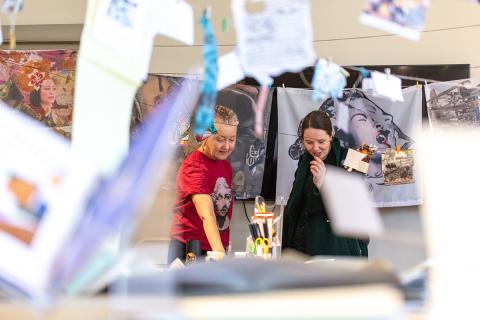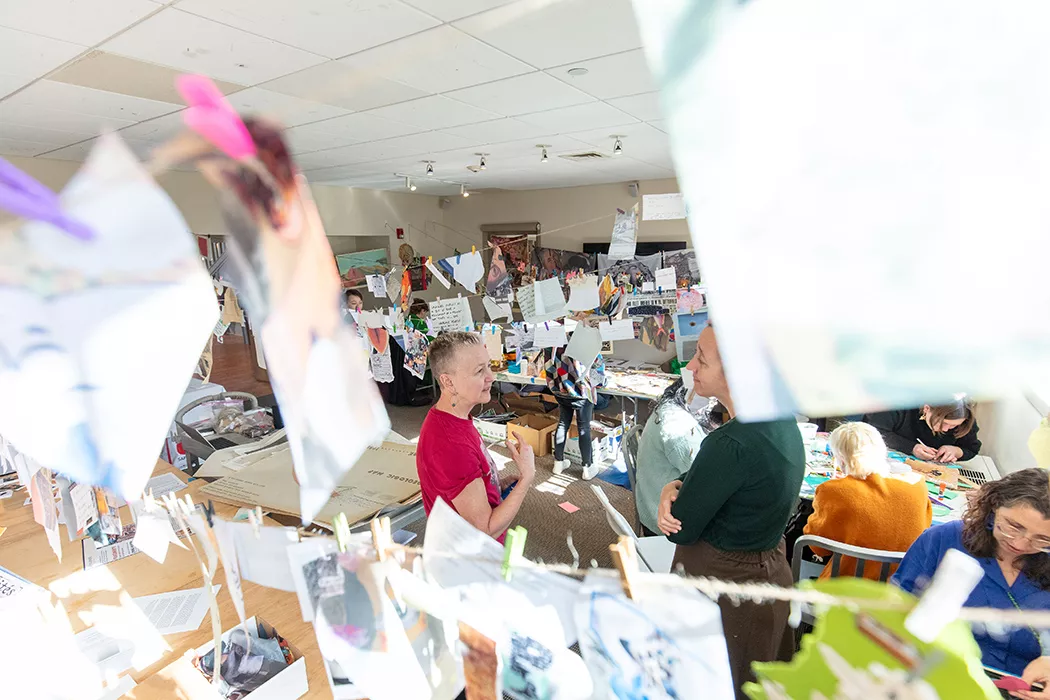Tied Together
In partnership with Special Collections, artist-philosopher Lynne Huffer leads students in collaborative collage

Collaborations between Special Collections and college partners, such as Museum Studies and the Center for Visual Culture, continue to bring artists to campus. Previous artists-in-residence included Ellie Ga (ongoing) and Bethany Collins (2023). This spring, Lynne Huffer became the most recent campus collaborator through an introduction from Professor of History of Art Alicia Walker.
Perhaps it was a party? The room nearest the Campus Center’s café was strewn with bits of paper littering the floor and hanging from the ceiling. But the swarms of invitees were almost silent, completely absorbed in their work, cutting and pasting, culling and connecting, making and unmaking an enormous, immersive installation of collage. Another artist residency was underway!
Artist-philosopher Lynne Huffer, professor of philosophy at Emory University, came to campus for three days this March to share her strategies for using collage as a research and writing tool. Recently, while struggling with a book project, Huffer found herself stringing lines across her living space and pinning key ideas, pictures, and quotations to them. She was finding a way to structure a book about fragments that preserved the experience of the fragmentary, through juxtaposition rather than narrative. Walking into her home felt like walking into her brain, she says.
Huffer restaged this installation in the Campus Center at Bryn Mawr but added empty strings for campus participants to populate. More than 100 members of the community entered the room over those three days, curiosity piqued by the strange outgrowths overtaking the space.
Many of us had no intention of picking up scissors and cutting a magazine, or taking a black marker and redacting typed text. Many of us planned to stay only a few minutes. Nearly all of us found ourselves pouring over our individual projects for hours. The odd comment punctuated the air, “I’m so glad you texted me about this. How did you know this was exactly what I needed to be doing right now?”
A deceivingly simple project, Huffer’s collage resonates profoundly. The activity reaches an audience exhausted by life online, reconnects us through in-person parallel play, frees us momentarily from our egos as we disappear into shape and color. Such practice can evolve into techniques, Huffer showed us, for revisiting our scholarship to excise less important passages or to allow for disruptions in our narratives.
Through a series of workshops, Huffer led exercises in found poetry, exquisite corpses, Sapphic fragments, and idea seed books. A math student approached her for advice on how to get out of her head, and left hours later declaring that she’d had “a breakthrough.” A philosophy student discovered bits of Hannah Arendt among the pages hanging from the stringed lines and took up a conversation with Huffer about her thesis subject.
College is hard. Our students are constantly challenged by new ideas and expectations as their sense of self is just beginning to form. And for today’s students, their concept of the future is imagined in relation to life on a planet in distress. Huffer’s project on fragments emerged from her philosophical engagement with how to think, live, and feel in the Anthropocene.
However, she says to the students, “what I felt in this room was joy.”
She quotes philosopher Gilles Deleuze’s definition of joy: everything that consists in fulfilling one’s capacities. By contributing their fragment to the larger installation, our community members created a collective artwork. They fulfilled capacities they may not have known they had, and they experienced joy.
Cultivating joy on campus has been a lodestar of Kim Cassidy’s presidency. For a community undergoing so much change and tumult in the world, this has not always been easy. But like the individual fragments that community members made and tied to transoms of string, we have hung in there, alone and together, always in relation to each other. Just as the collage needs each component fragment, we at the College need each other.
Published on: 05/28/2024




